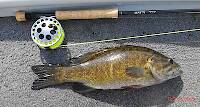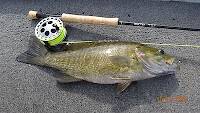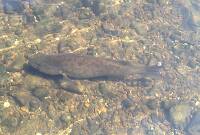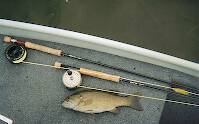
Blue-winged Olives
Baetis
Tiny Baetis mayflies are perhaps the most commonly encountered and imitated by anglers on all American trout streams due to their great abundance, widespread distribution, and trout-friendly emergence habits.
Featured on the forum

This is the first of it's family I've seen, collected from a tiny, fishless stream in the Cascades. The three species of this genus all live in the Northwest and are predators that primarily eat stonefly nymphs Merritt R.W., Cummins, K.W., and Berg, M.B. (2019).

Troutnut is a project started in 2003 by salmonid ecologist Jason "Troutnut" Neuswanger to help anglers and
fly tyers unabashedly embrace the entomological side of the sport. Learn more about Troutnut or
support the project for an enhanced experience here.
Martinlf on Jun 7, 2013June 7th, 2013, 7:57 am EDT
Two more bug questions.
1. On a PA limestone black quills of many sizes have manifested themselves this season. In early May, there were size 12 or 14 bugs on the water, and a few days later some size 16 black quills were spotted. They all were assumed to be Leptophlebia due to appearance and the time of emergence, though Ann Miller lists size 10-14 as the hook sizes. Has anyone observed Leptophlebia smaller than size 14, and if so what sizes?
2. Recently Telagonopsis deficiens showed up in its typical size 20. Other similar bugs are also present, though, in size 16 and 18, causing some confusion. Some believe these to be very dark Paraleptophlebias, while others have speculated thatTelagonopsis deficiens may come in sizes larger than size 20. Without photos, of course, actual identification is impossible, but has anyone noted size variablilty in Telagonopsis deficiens--do they ever reach size 18, or even 16?
All the bugs mentioned above had 3 tails.
1. On a PA limestone black quills of many sizes have manifested themselves this season. In early May, there were size 12 or 14 bugs on the water, and a few days later some size 16 black quills were spotted. They all were assumed to be Leptophlebia due to appearance and the time of emergence, though Ann Miller lists size 10-14 as the hook sizes. Has anyone observed Leptophlebia smaller than size 14, and if so what sizes?
2. Recently Telagonopsis deficiens showed up in its typical size 20. Other similar bugs are also present, though, in size 16 and 18, causing some confusion. Some believe these to be very dark Paraleptophlebias, while others have speculated thatTelagonopsis deficiens may come in sizes larger than size 20. Without photos, of course, actual identification is impossible, but has anyone noted size variablilty in Telagonopsis deficiens--do they ever reach size 18, or even 16?
All the bugs mentioned above had 3 tails.
"He spread them a yard and a half. 'And every one that got away is this big.'"
--Fred Chappell
--Fred Chappell
Taxon on Jun 7, 2013June 7th, 2013, 9:25 am EDT
Hi Lewis-
The following mayflies of genus Leptophlebia found in PA:
Species----EmergenceStart----EmergencEnd----SpinnerMinLen----SpinnerMaxLen
cupida-----mid-Apr-------------late-Aug-----------8 mm--------------12.5 mm
intermedia-------------------------------------------11 mm-------------9 mm ??
johnsoni---mid-Jun-------------early-Jul-----------9 mm--------------11 mm
nebulosa--mid-May-------------mid-Jun-----------11 mm-------------13 mm
Also, generally speaking, the females of a given species tend to be somewhat longer than the respective males.
Teloganopsis deficiens can apparently vary from 4.5-6 mm in adult body length.
The following mayflies of genus Leptophlebia found in PA:
Species----EmergenceStart----EmergencEnd----SpinnerMinLen----SpinnerMaxLen
cupida-----mid-Apr-------------late-Aug-----------8 mm--------------12.5 mm
intermedia-------------------------------------------11 mm-------------9 mm ??
johnsoni---mid-Jun-------------early-Jul-----------9 mm--------------11 mm
nebulosa--mid-May-------------mid-Jun-----------11 mm-------------13 mm
Also, generally speaking, the females of a given species tend to be somewhat longer than the respective males.
Teloganopsis deficiens can apparently vary from 4.5-6 mm in adult body length.
Martinlf on Jun 7, 2013June 7th, 2013, 1:47 pm EDT
Thank you, Roger; this is very helpful. So, if we use the shank length of a Tiemco 101 dry fly hook (hk = hook size) we have the following:
hk=mm:
8= 12
10=11
12= 9
14= 8
16= 7
18= 6
20= 5
It would appear that Leptophlebia can range from a size 8 (or slightly larger), down to a size 14, while Teloganopsis range from 18 to 20 (or slightly smaller).
Of course, hook sizes and angler's estimates of bug sizes are subject to a considerable variability, but it is clear that "black quills" come in many different sizes.
hk=mm:
8= 12
10=11
12= 9
14= 8
16= 7
18= 6
20= 5
It would appear that Leptophlebia can range from a size 8 (or slightly larger), down to a size 14, while Teloganopsis range from 18 to 20 (or slightly smaller).
Of course, hook sizes and angler's estimates of bug sizes are subject to a considerable variability, but it is clear that "black quills" come in many different sizes.
"He spread them a yard and a half. 'And every one that got away is this big.'"
--Fred Chappell
--Fred Chappell
Oldredbarn on Jun 10, 2013June 10th, 2013, 7:43 pm EDT
Louis...Sometimes the Little Mahogany and the Great Mahogany might look similar but are very different in size...Paraleptophlebia vs Leptophlebia...I wasn't there, but hey!?
I often wonder about all the books where we read about the so-called "super" hatches and there may be bugs out there that don't have that super-star status and we know little about them...Under the radar hatch.
The boys in Grayling would just tell you to tie on a Borchers and "forget about it!" :) A guide saying up there is, "When in doubt, tie on a Borchers."
Spence
I often wonder about all the books where we read about the so-called "super" hatches and there may be bugs out there that don't have that super-star status and we know little about them...Under the radar hatch.
The boys in Grayling would just tell you to tie on a Borchers and "forget about it!" :) A guide saying up there is, "When in doubt, tie on a Borchers."
Spence
"Even when my best efforts fail it's a satisfying challenge, and that, after all, is the essence of fly fishing." -Chauncy Lively
"Envy not the man who lives beside the river, but the man the river flows through." Joseph T Heywood
"Envy not the man who lives beside the river, but the man the river flows through." Joseph T Heywood
TNEAL on Jun 11, 2013June 11th, 2013, 12:20 pm EDT
right you are , Spence. And why not, with 8 20-25" fish taken in two days of Hendricksons on a size #14 Borchers?
Tight lines, Tim
Tight lines, Tim
Martinlf on Aug 28, 2013August 28th, 2013, 5:08 pm EDT
Bumping this up as it relates to Eric's "August ephemerelid" thread. Roger notes Teloganopsis can vary from 4.5-6 mm. This seems close enough, especially if there is any margin of error.
"He spread them a yard and a half. 'And every one that got away is this big.'"
--Fred Chappell
--Fred Chappell
Quick Reply
Related Discussions
Topic
Replies
Last Reply








